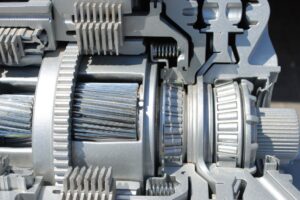The Honda CRV has stormed the American market regarding crossover SUVs. It can provide handling similar to a Civic Type R while also being extensively spacious.
A pre used CRV is a good choice for your next vehicle. However, checking in on past transmission problem complaints is something that I will definitely recommend.
A lot of people may be under the impression that the Honda CRV is a pretty reliable car. People have documented several Honda CRV transmission problems on specific models in the past.
I have listed them out below for your convenience:
- There’s No Throttle Response
- The Engine Light Turns On
- Vehicle Shudder Problems While Driving Or Idling
- Shift Lever Problems
- Leaking Or Low Transmission Fluid
- Fuel Leaking Into The Engine Oil
- Issues With Properly Shifting From 3rd To 4th Gear
- Torque Converter Issues
- Valve Body Issues
- Noisy Transmission In Neutral
- Car Going Into Neutral When Reserving
- A Dragging Clutch
- Trouble Codes
- A Burning Smell In The Car
Despite having an edge over most other crossover SUVs, these problems can cause a frustrating driving experience and can be an expensive fix.
Table of Contents
- 1 14 Signs Of Transmission Problems In A Honda CRV
- 1.1 1. There’s No Throttle Response
- 1.2 2. The Engine Light Turns On
- 1.3 3. Vehicle Shudder Problems While Driving Or Idling
- 1.4 4. Shift Lever Problems
- 1.5 5. Leaking Or Low Transmission Fluid
- 1.6 6. Fuel Leaking Into The Engine Oil
- 1.7 7. Issues With Properly Shifting From 3rd To 4th Gear
- 1.8 8. Torque Converter Issues
- 1.9 9. Valve Body Issues
- 1.10 10. Noisy Transmission In Neutral
- 1.11 11. Car Going Into Neutral When Reserving
- 1.12 12. A Dragging Clutch
- 1.13 13. Trouble Codes
- 1.14 14. A Burning Smell In The Car
- 2 How To Prevent Your Honda CRV’s Transmission Issues
- 3 How To Fix The Honda CRV’s Transmission Problems
- 4 Which Year Did Honda CRV Have Transmission Troubles?
- 5 Frequently Asked Questions
- 6 Conclusion
14 Signs Of Transmission Problems In A Honda CRV

If you just wanted a rough idea about what these problems could be, this much information should suffice.
However, there are quite a few nuances regarding each of these aforementioned issues.
This is why I have gone ahead and summarized them for you, so I recommend reading the article till the end.
1. There’s No Throttle Response
A common problem that people face with their Honda CRV is that the transmission does not shift correctly. This results in decreased speed and acceleration.
So when you floor that accelerator and your car does not accelerate as fast as it should, there is a high probability that it’s due to the transmission having a hard time shifting.
2. The Engine Light Turns On
The engine light can be quite intimidating since it does not have a specific reason for suddenly popping up.
This usually occurs only due to a faulty oxygen sensor or catalytic converter. However, it can also mean that there’s an issue with the transmission itself.
3. Vehicle Shudder Problems While Driving Or Idling
Honda CRVs with this issue tend to start vibrating intensely at stops.
Some recorded instances also show that while accelerating from a stop, the car vibrates even more. This intense vibration can very well be caused by a problem in the transmission.
4. Shift Lever Problems
Experiences of a faulty shift lever caused by transmission issues have been recorded as well. The lever can also lock in one place and in some cases pop out.
Trouble changing gears is commonly caused by a failed transmission solenoid, low fluid levels, or maybe just a slipping clutch.
5. Leaking Or Low Transmission Fluid
Leakage of transmission fluid is another common problem with Honda CRV’s automatic transmissions.
A layer of red oily substance forms underneath the car. Its color can range from red to dark brown and even black, depending on how old the lubricant is.
Despite being so common, it can severely damage the inside of your transmission.
6. Fuel Leaking Into The Engine Oil
Another dangerous transmission issue is the leakage of fuel straight into the engine oil compartment.
This leads to a direct engine stall or even a complete loss of power while driving.
Lastly, this is not as common as the last leakage issue; this seems to happen mostly in cold weather.
7. Issues With Properly Shifting From 3rd To 4th Gear
Faulty transmission prevents proper shifting of the 3rd gear to the 4th gear.
This usually happens because of faulty or worn-out throttle cables. This damaged line may have trouble shifting, especially if it has too much extra slack.
8. Torque Converter Issues
The torque converter failure could be another possible problem with a Honda CR-V.
This can cause a range of issues like; faulty shifting, slipping gears, sudden stoppage of the car, and you might also see some leaked transmission fluid. However, this is not very likely.
9. Valve Body Issues
The Honda CRV has been repeatedly reported with the issue of having a malfunctioning valve body.
The valve body controls how fast or how slow the transmission shifts gears. If it’s faulty, it can lead to jerky gear shifts, no gear shifting at all, and even some fluid leaks.
10. Noisy Transmission In Neutral
If you find the car’s transmission making a lot of noise while in neutral, it is either because of lack of fluid/incorrect fluid use, or it can be because of worn out gears.
If the fluid is not topped up then and there and you fail to notice this noise, you could end up damaging the entire transmission.
11. Car Going Into Neutral When Reserving
Many automatic transmissions tend to go into neutral when reserving.
This can be caused due to many different reasons the most common ones being; damaged cables and misaligned linkages.
However, many instances also show that this is an internal issue like a clogged filter and blocked passageway.
12. A Dragging Clutch
A dragging clutch is one of many things that can cause you trouble with automatic transmission.
If the clutch plates are not working correctly or even if they are just worn out, they will not disengage from the engine while attempting to shift gears, leading to a dragging clutch.
13. Trouble Codes
There are hundreds of trouble codes on the Honda CRV. Every code differs but these usually pop up due to a problem with the valve body.
The valve body is the part that controls how fast the transmission shifts gears. A problem with this can lead to some trouble codes popping up.
14. A Burning Smell In The Car
If the windows are rolled up and you smell something burning in your car, it is most likely an issue with your transmission.
This can be caused by a problem with your car’s clutch plates, or it can be simply overheated transmission fluid. Either way, ignoring would lead to further damage to the transmission.
How To Prevent Your Honda CRV’s Transmission Issues
The Honda CRV can have quite an expensive transmission replacement.
So it is better to notice the signs that your car gives you and act upon them to prevent any of these expensive mishaps.
1. Check Transmission Fluids
First and foremost, make sure your transmission fluid levels are within the recommended range.
If the transmission filter has not been changed in a bit, make sure to change it as it can prevent all interior gear issues other than those caused by clutch plates.
Get the car’s automatic transmission serviced regularly.
2. Switch Gears Properly
While driving, always switch gears properly, this is vital for the transmission to continue working as it should.
Gear shifting issues can be fixed with the adjustable shift cables, however, if you are not experienced with it, do not hesitate to take your Honda CRV to the mechanic.
3. Use Of Parking Brakes
When parking on an incline, use your parking brake.
Even though cars have pins that prevent them from rolling down, but, they are easily worn out and it causes unnecessary load on your transmission.
4. Avoid Overheating Transmission
Overheating the transmission causes cracks in the transmission and damaged gears.
Check on your transmission fluid levels at regular intervals just as the vehicle manufacturer specifies.
5. Let Your Honda CRV Warm Up
Always let your vehicle warm up in the morning, just a 30 to 60 second warm up is enough to make the transmission fluids running and be ready for driving.
Without a warm up, the moving parts of the car aren’t lubricated and they just grind on each other which can lead to other problems.
6. Do Not Overload The Vehicle
Never overload your vehicle by towing something it cannot withstand. You can avoid mechanical failure simply by following the towing limit the manufacturer has provided.
How To Fix The Honda CRV’s Transmission Problems

Every time you notice a sign of a problem related to the transmission, make sure to take your car to the mechanic for a diagnostic check.
The mechanic has the tools and can identify the problem before it becomes a problem far greater than it was like transmission failure.
In many cases, it may not be feasible or possible for you to fix the transmission yourself which is why taking the car to the mechanic is always a good option.
Over there you can get the component fixed. If it is beyond repair then your only choice will be to get it replaced.
As long as you follow the tips mentioned in this article, you should be able to avoid any major issues with the transmission.
Which Year Did Honda CRV Have Transmission Troubles?
Over the years Honda CRV has had many yearly models with transmission problems. Let’s take a look at exactly which models had these problems and what they were.
1999 Honda CR-V
The most common transmission problem was its fluid leaks and low fluid levels. The torque converter had damaged needle bearings.
Lack of fluid levels caused the solenoid to act up and cause problems as well. The clutch would be delayed due to the solenoid acting up and lack of fluid levels.
2002 Honda CR-V
While accelerating with shift delays, the 2002 Honda CR-V would be grinding and jumping, shaking at any speed.
Whistling noises could be heard constantly and a pungent burning smell coming from the hood.
2003 Honda CR-V
The 2003 CRV has slipping gears that fluctuate between switching early and late.
A grinding sound could be heard constantly while driving. The transmission fluid would leak almost every time it stood still for a while.
2005 Honda CR-V
Electrical problems cause error codes to pop up even though the transmission had nothing wrong with it.
Sitting in one place for the slightest time caused heave fluid leakage. Gear shifting while driving causes loud creaks and the shifts were generally delayed.
2012 Honda CR-V
The gear shifts were very delayed and there were loud grinding sounds.
Transmission fluid being burnt produced strange smells. Fluid leaks were common and the transmission warning light would be on all the time.
2013 Honda CRV
Owners of the 2013 Honda CRV complained because of loud whining sounds and constant powerful rattling while driving.
The shifts were being delayed and the transmission refused to switch gears.
2014 Honda CR-V
2014 model was reported to have a transmission that sent vibration and heavy rattling whenever the car was driven at low acceleration.
This affected the handling of the car when driving and abnormally delayed the shift lever.
2015 Honda CR-V
The car would be slipping while driving. The automatic transmission frequency would be switching to neutral or even reverse while driving.
It would sometimes just randomly decelerate at an abnormal rate and eventually stall for no reason.
2018 Honda CR-V
Potentially the most dangerous defect caused the car’s fuel would seep into the engine oil compartment and eventually lose complete power and stall while driving.
This mostly took place in cold weather areas.
2021 Honda CR-V
Changing gears caused loud creaking sounds and clearly showed that they were not fully lubricated from the inside.
Transmission fluid burning away produces burning smells. The transmission would shift gears but the result of the shift would be delayed.
Related: https://taxihack.com/best-and-worst-years-for-honda-crv/
Frequently Asked Questions
Q1. How Much Does A Honda CRV Transmission Replacement Cost?
The latest model Honda CRV’s transmission replacement can cost well over $35,000.
But it depends on the model. Other services like transmission fluid changes etc are comparatively less expensive; under $150.
If the transmission fluid is serviced regularly then a replacement will not be needed at all.
Q2. What Is The Lifespan Of A Honda CRV’s Transmission?
Again depends upon the model, but the average Honda CRV transmission should be able to last between 120,000 and 180,000 miles before needing a replacement.
If the transmission is kept in good condition, the lifespan can be increased. Regular transmission fluid flush and filter changes according to the manufacturer should be helpful.
Related: https://taxihack.com/how-long-do-honda-crv-last/
Q3. Is It Safe To Drive A Honda CRV With A Bad Transmission?
You should never drive your car if you know there is a problem with your transmission.
Once the signs of a transmission problem come forth, make sure to get it fixed and serviced immediately.
It can be extremely dangerous to drive your Honda CRV with a bad transmission which is why you should avoid it.
Conclusion
The Honda CRV is one of the best crossover SUVs in the market. But despite this, the people who have previously owned this car might disagree.
The transmission problems that have been prevalent in the lineup have severely hurt its reputation over the years.
In any case, if you are still interested in getting a Honda CRV, you should have a good idea about all of these issues and how to identify them.
Now that you have fully read this article, not only should you have the answer to Honda CRV transmission problems but also the means to get them fixed.

I am Tahir Azam, and I have been writing amazing articles for TaxiHack for as long as I can remember. I know everything that is to know when it comes to automobiles and is always on top of industry news and developments. While I am not an expert by any means, I pride myself on knowing the ins and outs of many different problems and, of course, their solutions. The articles on our website are some of the best and well-researched content that you will find, and I spend countless hours making sure this remains to be true. This is why I ask you to take your time out and read some of my articles, especially if you find a topic that resonates with you or is something you are looking into. This way, you will find the perfect mix of information and tips on your desired topic. Learn more about Tahir.



